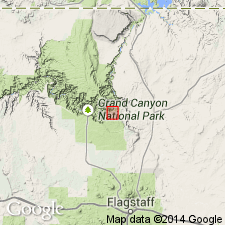
- Usage in publication:
-
- Escalante Creek Member*
- Modifications:
-
- Named
- Dominant lithology:
-
- Sandstone
- Shale
- Mudstone
- AAPG geologic province:
-
- Southern Rocky Mountain region
Summary:
Named as the lowermost of four members of Dox Formation (redefined) of Unkar Group [of Grand Canyon Supergroup] for exposures along Escalante Creek, east side Grand Canyon of Colorado River, Coconino Co, AZ in Southern Rocky Mountain region, designated the type section. Is also exposed along North Kaibab Trail in Bright Angel Canyon and along Shinumo Creek. Four units recognized. Unit 1 (base) is a white to grayish-tan, friable, medium-grained quartz sandstone 73 m thick with minor amounts of interbedded dark green to black, slope-forming shale. Most distinctive feature in lower is the contorted sandstone indicative of slurry slumps. Unit 2 is an 80 m thick sequence of green to brown shale, mudstone, and sandstone. Micaceous shale and mudstone make up 70 percent of unit. Unit 3 is a resistant cliff-forming feldspathic calcareous sandstone 96 m thick. Unit 4 (top) is a 140 m thick less resistant interbedded brown to gray siltstone and green brown sandstone. Top placed where brown mudstone grades into red-orange siltstone or sandstone of Solomon Temple Member (new). Overlies Shinumo Quartzite. Is a transgressive and regressive prodelta and delta deposit formed in a marginal marine environment in late Precambrian time. Geologic map.
Source: GNU records (USGS DDS-6; Denver GNULEX).
For more information, please contact Nancy Stamm, Geologic Names Committee Secretary.
Asterisk (*) indicates published by U.S. Geological Survey authors.
"No current usage" (†) implies that a name has been abandoned or has fallen into disuse. Former usage and, if known, replacement name given in parentheses ( ).
Slash (/) indicates name conflicts with nomenclatural guidelines (CSN, 1933; ACSN, 1961, 1970; NACSN, 1983, 2005, 2021). May be explained within brackets ([ ]).

